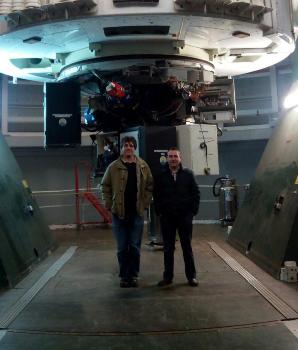Feb 26 2016
A team of Spanish researchers, with the participation of the University of Granada (UGR), has accurately detected a structure in the innermost region of a quasar (small, very far objects that emit huge amounts of energy, comparable to that emitted by a whole galaxy) at a distance of more than five billion light-years from Earth.
 Two of the authors of this paper: Evencio Mediavilla (IAC) and Jorge Jímenez Vicente (UGR). Credit: Two of the authors of this paper: Evencio Mediavilla (IAC) and Jorge Jímenez Vicente (UGR).
Two of the authors of this paper: Evencio Mediavilla (IAC) and Jorge Jímenez Vicente (UGR). Credit: Two of the authors of this paper: Evencio Mediavilla (IAC) and Jorge Jímenez Vicente (UGR).
It's the most accurate measure achieved until now of such a small and distant object, and it has been achieved thanks to the so-called gravitational microlensing effect, caused by stars belonging to a galaxy between us and the quasar, and which may magnify tiny regions within the quasar.
In particular, the researchers have managed to measure the inner edge of the disk of matter (accretion disk) orbiting around the quasar Q2237+0305 (known as "Einstein Cross") through the study of the changes in the brightness of four different images of said quasar. Said images were obtained thanks to the OGLE (Optical Gravitational Lensing Experiment) and GLITP (Gravitational Lensing International Time Project) experiments, which monitored that quasar for 12 years and for 9 months, respectively.
In the frontier of a black hole
A quasar emits its energy due to a disk of hot matter orbiting around a supermassive black hole at high speed, and whose mass is the equivalent to a billion stars. Said disk's size is comparable to that of our Solar System but, being so far from us, it's not possible to measure its structure by usual means. In this case, it has been possible thanks to the gravitational microlensing effect, which has allowed the researchers to detect a structure in the disk's inner edge, in the very border of the black hole.
Other than the UGR, this work has counted with the participation of researchers from the Instituto de Astrofísica de Canarias (IAC) astrophysical research institute, the University of Valencia (UV) and the University of Cadiz (UCA).
As Jorge Jiménez Vicente, researcher at the UGR department of Theoretical Physics and Cosmology and one of the authors of this paper, explains: "the breakthrough of this work has been that we've been able to detect a structure in the inner edge of such a small disk at such a great distance, thanks to the gravitational microlensing effect. It would be the equivalent to detecting an Euro coin at a distance of more than 100000 kilometers".
Only 1 in 500 quasars is affected by the gravitational microlensing effect. The information obtained will be very useful for understanding quasars, which in turn is essential to understanding how the galaxies were born and evolve.
Jiménez Vicente notes that, in the future, when great monitoring programs are available, "the possibility of detecting high magnification events caused by the gravitational microlensing effect could be applied to thousands of quasars". An example of said monitoring programs is the planned Large Synoptic Survey Telescope, a telescope with a primary mirror of 8,4 meters in diameter, capable of analyzing the whole visible sky. It will be constructed in the north of Chile and will begin to operate in 2022.